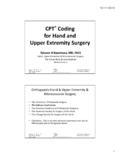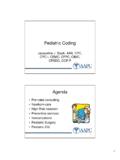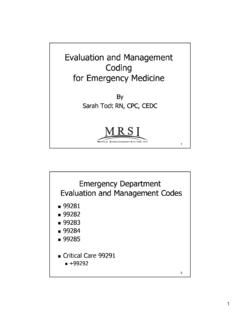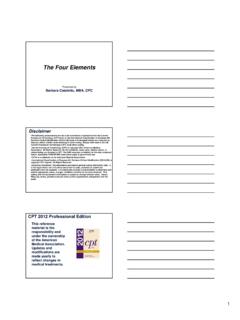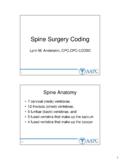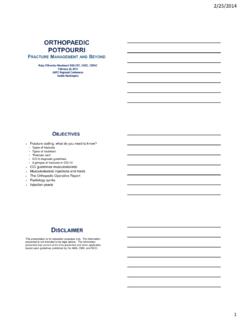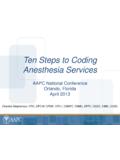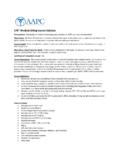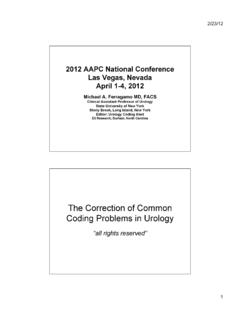Transcription of ICD-10-CM Commonly Coded Conditions For Urology - AAPC
1 2/11/2014. ICD-10-CM Commonly Coded Conditions For Urology 1. No part of this presentation may be reproduced or transmitted in any form or by any means (graphically, electronically, or mechanically, including photocopying, recording, or taping) without the expressed written permission of AAPC. 22 Commonly Coded Conditions in Urology Commonly Codes Conditions Erectile Dysfunction Hypospadias Urinary Incontinence Hematuria (other abnormal urologic findings). Calculus Hydrocele and Spermatocele Neurogenic Bladder Benign Prostatic Hypertrophy (BPH). Neoplasms 3 Commonly Coded Conditions in Urology 1. 2/11/2014. Erectile Dysfunction Two types of erectile dysfunction with two code categories Psychological Physiological F52 contains an Excludes 2 note indicating both Conditions could occur at the same time, and both would be reported 4 Commonly Coded Conditions in Urology Example Paul presents for evaluation.
2 He began taking a selective serotonin re-uptake inhibitor (SSRI) anti- depressant last month and shortly after began suffering erectile dysfunction. He states that he takes the medication as prescribed. He is determined to have drug-induced erectile dysfunction. Drug-induced erectile dysfunction Adverse effect of SSRI, initial encounter 5 Commonly Coded Conditions in Urology Hypospadias Congenital abnormality Code selection is based on site of the urethral opening balanic: Malposition of urethral meatus on the ventral glans penis penile: Malposition of urethral meatus on the shaft of the penis penoscrotal: Malposition of urethral meatus at the junction of the penis and scrotum perineal: Malposition of urethral meatus in the perineum near the anus Q54. 4 Congenital chordae Other Hypospadias 6 Commonly Coded Conditions in Urology 2.
3 2/11/2014. Example A 1 -year-old presents to the operating room for Hypospadias (TTT repair and flap relocation) and Nesbit chordae release. He has penoscrotal Hypospadias and congenital chordae Hypospadias, penoscrotal Congenital chordae 7 Commonly Coded Conditions in Urology Urinary Incontinence Codes (most ) are located in category N39. Causes of urinary incontinence Pregnancy, childbirth Aging Physical problems /changes Enlarged prostate Neurologic disorders Some Types of UI. Stress Urge Mixed Overflow Instructional note in category to code also any associated overactive bladder. 8 Commonly Coded Conditions in Urology Example The patient presents for cystoscopy with a diagnosis of recurring bladder infections and urge incontinence, not helped by Detrol LA.
4 The flexible scope is placed through the meatus into the bladder. The bladder was systematically scanned with no abnormal findings of erythema, tumor, or foreign body. Urge incontinence Personal history of urinary (tract) infections 9 Commonly Coded Conditions in Urology 3. 2/11/2014. Hematuria Category R31. Gross hematuria Benign essential microscopic hematuria Other microscopic hematuria Hematuria, unspecified Category N02. Recurrent and Persistent hematuria with underlying Conditions Listing in manual 10 Commonly Coded Conditions in Urology Example Patient presents for renal biopsy results. She had originally presented with a history of persistent rust colored urine, but no bright red blood or clots in the urine. CT scan was negative for kidney stones. Renal biopsy results indicate ten Glomerular were present with crescents in eight of them.
5 The Glomerular sections evaluated showed no electron-dense deposits in the filtration membrane or mesangium. She is diagnosed with diffuse crescentic glomerulonephritis with persistent hematuria. recurrent and persistent hematuria with diffuse crescentic glomerulonephritis 11 Commonly Coded Conditions in Urology Other Abnormal Findings Category R30 Pain associated with micturition Category R33 Retention of urine has instructional notes Category R34 Anuria and oligouria Category R35 Polyuria Category R36 Urethral discharge Category R39 Other and unspecified 12 Commonly Coded Conditions in Urology 4. 2/11/2014. Example A 70-year-old male patient presents with nocturia, and dysuria without trauma or provocation. He states this has been occurring off and on, becoming more persistent.
6 Considering patient's age, may be BPH. Will obtain UA with culture, PSA, and ultrasound. Nocturia Dysuria 13 Commonly Coded Conditions in Urology Calculus Four major types of stones Codes are specific to location Kidney, ureter, bladder, urethra, multiple areas Categories N20 through N22. Category N22 contains an instructional note that states to code first the underlying disease 14 Commonly Coded Conditions in Urology Example Urology is called when a male patient presents with sharp pain in the lower back that comes in waves and pain on urination. CT indicates large right Ureteral stone Calculus of ureter 15 Commonly Coded Conditions in Urology 5. 2/11/2014. Example Brian presents to the clinic. He has chronic idiopathic gout in the right foot that has flared up.
7 He ws referred for evaluation as he now has kidney stones. Idiopathic chronic gout, right ankle and foot without tophus N22 Calculus of urinary tract in diseases classified elsewhere 16 Commonly Coded Conditions in Urology Other codes Other codes that relate to calculus of the urinary system: Other specified congenital malformations of kidney; congenital kidney stones Hydronephrosis with renal and Ureteral calculous obstruction Pyonephrosis: urinary tract obstruction, may be from calculus, with infection Instructional note with this code to use additional code (B95-B97) to identify infectious agent Excludes 2 note with Category N13, Obstructive and reflux uropathy 17 Commonly Coded Conditions in Urology Hydrocele/Spermatocele Hydrocele Code selection based on Congenital or Non-congenital Congenital hydrocele Category - Non-congenital hydrocele Spermatocele Typically asymptomatic 3 codes for non-congenital Congenital spermatocele 18 Commonly Coded Conditions in Urology 6.
8 2/11/2014. Example A male patient presents with swelling in the groin. He admits to no trauma and states he noticed it a couple of days ago. On exam, swelling was noted in the left inguinal region that moved downward when the testis was gently pulled downward. US. confirmed encysted hydrocele. Encysted hydrocele 19 Commonly Coded Conditions in Urology Neurogenic Bladder Category N31. Common causes of neurogenic bladder Stroke Multiple sclerosis Spina bifida Traumatic spinal cord injury Code selection based on Type Uninhibited, reflex, flaccid, other, neuromuscular Instructional note for category N31 states to use an additional code for associated urinary incontinence ( , ). 20 Commonly Coded Conditions in Urology Example A patient presents for treatment options with a reflex neurogenic bladder with stress incontinence.
9 After review of diagnostic studies and physical exam, treatment options were discussed. Treatment started with bethanechol 25 mg orally four times a day. Reflex neuropathic bladder, not elsewhere classified Stress incontinence (male) (female). 21 Commonly Coded Conditions in Urology 7. 2/11/2014. Benign Prostatic Hypertrophy Category N40. Divided by type Enlarged or nodular With or without lower urinary tract symptoms (LUTS). Enlarged prostate w/o LUTS. Enlarged prostate with LUTS. Nodular prostate w/o LUTS. Nodular prostate with LUTS. 22 Commonly Coded Conditions in Urology LUTS. Instructional note for and state to code also associated symptoms. Incomplete emptying ( ). Nocturia ( ). Straining on urination ( Urinary frequency ( ). Urinary hesitancy ( ). Urinary incontinence ( ).)
10 Urinary obstruction ( ). Urinary retention ( ). Urinary urgency ( ). Weak urinary stream ( ). This instruction is the same as in ICD-9. 23 Commonly Coded Conditions in Urology Example A 58-year-old man presents for follow-up. He presented originally for urinary frequency, hesitancy, weak stream, and nocturia, for over 2 years with recent progression. Physical exam revealed soft and enlarged prostate 30g. His IPSS score was 18 (moderate). We discussed his labs today, showing normal U/A and PSA of ng/Ml. He states there is not change in his symptoms. Patient is diagnosed with enlarged prostate with LUTS and started on alpha- blockers . Enlarged prostate with LUTS. Frequency of micturition Hesitancy of micturition Poor urinary stream Nocturia, 24 Commonly Coded Conditions in Urology 8.
